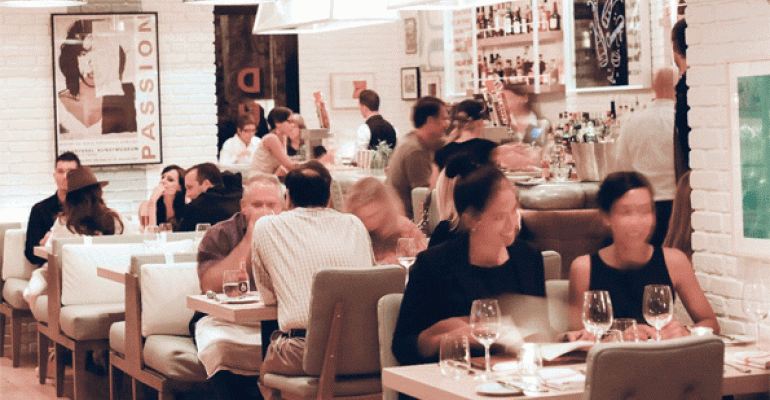 Then-New York Times restaurant critic Frank Bruni was more than a little disappointed when chef Andrew Carmellini skipped out on fine dining in 2009 to open a place that served simple food in a casual setting. “Locanda Verde doesn’t amount to the exactly right situation or perfect fit for him” Bruni wrote. “It’s not the Carmellini restaurant that many of us have been waiting for.”
Then-New York Times restaurant critic Frank Bruni was more than a little disappointed when chef Andrew Carmellini skipped out on fine dining in 2009 to open a place that served simple food in a casual setting. “Locanda Verde doesn’t amount to the exactly right situation or perfect fit for him” Bruni wrote. “It’s not the Carmellini restaurant that many of us have been waiting for.”
Bruni was sending a message that he expected Carmellini, a two-time James Beard Award-winner who had spent his career in high-end Italian and classical French restaurants (Lespinasse, Le Cirque, Café Boulud) and earned a Michelin star in his first role as executive chef (A Voce), to aim higher than a taverna-style restaurant that merely gave New Yorkers a nice place to hang out.
Turns out Carmellini knew more about what New Yorkers wanted than Bruni did. Locanda Verde, which grossed $15 million in 2009, is still red-hot. His next restaurant, The Dutch, was even hotter. Bruni’s replacement, Sam Sifton, tabbed The Dutch, an American-style take on the good food-casual vibe format, “my restaurant of the year” for 2011. Now the ever-entrepreneurial Carmellini has opened a second unit of The Dutch inside the W Hotel in Miami Beach.
Carmellini is no stranger to Miami. “In the 1940s and 1950s, my grandfather was the general manager of the Surf Club,” he tells Miami’s New Times. “My father was raised in Miami and I’ve been coming here since I was zero.” He says he looked for a Miami-area location for a long time before signing a lengthy lease at the W.
Now we’ll find out if the scene-makers in Miami Beach, of whom there are many, will embrace The Dutch Miami as warmly as their counterparts in New York did the original. They’ll notice right away that the place has nothing to do with Dutch cuisine. Instead, “It’s American food the way we see it today. Roots-inspired dishes are shaped for big-city palates with the best ingredients, better technique and some neighborhood charm,” Carmellini says.
 The restaurant’s morning menu offers a classy take on breakfast, and provides plenty of markup. The classic combo offering two eggs any style, skillet potatoes, toast, choice of bacon or sausage, choice of juice and coffee or tea goes for $24. The breakfast buffet is priced at $28.
The restaurant’s morning menu offers a classy take on breakfast, and provides plenty of markup. The classic combo offering two eggs any style, skillet potatoes, toast, choice of bacon or sausage, choice of juice and coffee or tea goes for $24. The breakfast buffet is priced at $28.
Lunch provides an eclectic sampling of the dinner menu, with prices knocked down a dollar or two, plus a strong lunch-specific lineup. The appetizer choices include roasted beets with grapefruit, pistachio and local goat cheese ($13), octopus la barca ($17) and Asian white boy ribs ($15). The pizzette lineup includes a truffle bianco, goat cheese and pancetta version ($20) and a blue crab, tomato zucchini and jalapeño combination ($18). The grouper kuroyaki sandwich with yuzu and tomato goes for $16, the cheddar burger is $17 and fried chicken with slaw and honey butter biscuits costs $19.
The Dutch Miami’s dinner choices appeal to a wide range of appetites and tastes. Seafood fans can start with something as simple as slider-style oyster sandwiches ($5 each) or opt for much more expensive plates. The Collins platter provides oysters, little necks, shrimp, octopus, crab salad, chilled lobster, yellowtail and stone crab for $125. American caviar with brioche and garnishes costs $95, yet blue point oysters go for just $2.50 each yellowtail crudo with watermelon and jalapeño ($19).
 The three-item pasta lineup ranges from trofie with pesto, sweet peppers and pine nuts ($18) to grandma’s ravioli with taleggio fonduta and black truffle ($38).
The three-item pasta lineup ranges from trofie with pesto, sweet peppers and pine nuts ($18) to grandma’s ravioli with taleggio fonduta and black truffle ($38).
Entrées provide expected standards (Guinness-braised short ribs and Yukon gold potatoes, $35) and a few adventurous options (steamed red snapper, peanuts, kaffir-curry sauce, $19). There are nods to Florida-centric fare (crispy Florida pompano, local zucchini, rock shrimp, $35) up and down the menu. Steak lovers have two options: an 18 oz. dry-aged bone-in New York Strip ($48) or a 40 oz. dry-aged beef ribeye for two $105.
The dessert list is short but memorable. Both the cocktail and wine lists are smartly crafted to make the most of Miami Beach’s propensity to party.
Carmellini and his partners, Josh Pickard and Luke Ostrom, took a big risk on The Dutch Miami project. There was no guarantee their concept, a huge hit in New York City, would have relevance to the South Beach dining public. But this trio delivered a culinary and operational juggernaut that was an instant smash. Given their track record, we can’t wait to see what this trio comes up with next.





